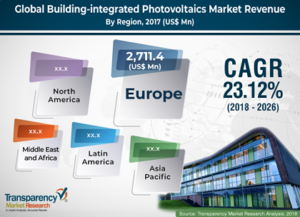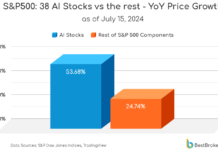
The global building-integrated photovoltaics (BIPV) market was valued at around US$ 5 Bn in 2017 and is anticipated to expand at a CAGR of more than 23% from 2018 to 2026, according to a new research report titled ‘Building-integrated Photovoltaics Market – Global Industry Analysis, Size, Share, Growth, Trends, and Forecast, 2018–2026,’ published by Transparency Market Research (TMR). Building-integrated photovoltaics (BIPV) is a technology that integrates solar elements into buildings to generate electricity.
Multifunctional features and aesthetic look
BIPV products provide additional functionalities to a building unlike traditional construction materials. Use of the BIPV technology converts buildings from energy consumers into energy producers. In order to achieve this, the construction technology is required to be merged with the BIPV technology. Here, photovoltaic modules serve the purpose of building exteriors, such as roofs, facades, and skylights. BIPVs protect buildings from climatic conditions and noise. Also, they offer thermal insulation. Rooftop solar photovoltaic (PV) systems are gaining popularity, due to scarcity of ground space and availability of unused roof space. The BIPV technology reduces total building material costs and mounting costs, as BIPVs do not require brackets and rails. Hence, their popularity has been increasing continuously. Designers and architects use BIPV products with innovative methods, whereas manufacturers continue to develop new products to meet the rising demand. Companies such as Sanyo, SCHOTT Solar, Sharp, and SUNTECH are working on the new BIPV products for facades, skylights, and windows.
Crystalline silicon to remain a dominant technology segment
Among technologies, the crystalline silicon segment dominated the global BIPV market in 2017. Two types of crystalline silicon photovoltaics are used i.e. monocrystalline silicon and polycrystalline silicon. Crystalline silicon glass can be easily customized, especially in terms of shape, as trapezoids can be easily fabricated by using this technology.
Major norms and regulations related to building-integrated photovoltaics market
- The Renewable Energy Directive establishes an overall policy for the production and promotion of energy from renewable sources in the European Union (EU). It requires the EU to fulfill at least 20% of its total energy needs from renewables by 2020.
- The new Directive 2018/844/EU introduces targeted amendments to Directive 2010/31/EU, aimed at accelerating cost-effective renovation of existing buildings, with the vision of decarbonization of all buildings and mobilization of investments by 2050. The revision also supports deployment of electro-mobility infrastructure in parking lots of buildings and introduces new provisions to enhance smart technologies and technical building systems, including automation.
- The Directive 2010/31/EU on the Energy Performance of Buildings (hereinafter called the ‘EPBD’) is the primary legislative instrument at the EU level for improving energy efficiency of buildings in Europe. A key element of the EPBD, especially for achieving long-term objectives, is its requirements regarding nearly zero-energy buildings (hereinafter called ‘NZEBs’).
Article 9(1) of the EPBD requires Member States to ensure that:
- By December 31, 2020, all new buildings are nearly zero-energy buildings; and
- After December 31, 2018, new buildings occupied and owned by public authorities are nearly zero-energy buildings.
Facades segment dominates the global building-integrated photovoltaics market
Among applications, the facades segment dominated the global building-integrated photovoltaics market, holding more than 30% of the market share, in terms of value, in 2017. A facade is the principal front of a building, which faces a street or open space. Some of the advantages of using PVs on facades include protection of the building from excessive solar radiations. They can also provide an alternative for expensive cladding in prestigious buildings. The facades segment was followed by the roofs segment in 2017.

















